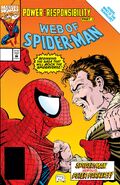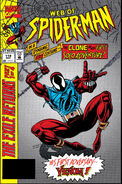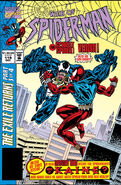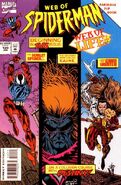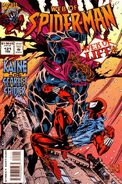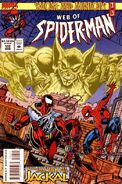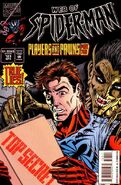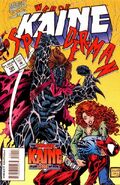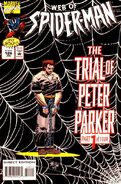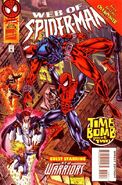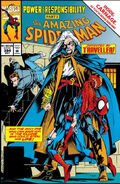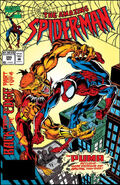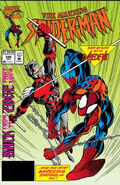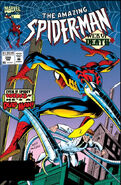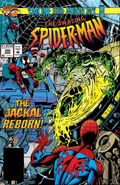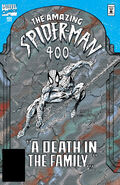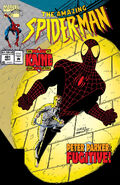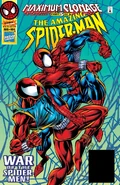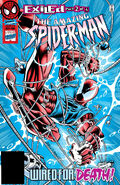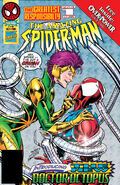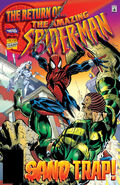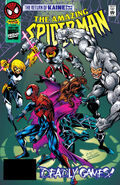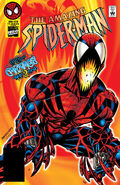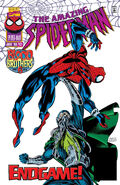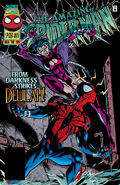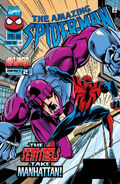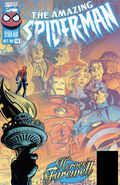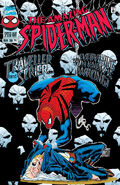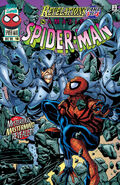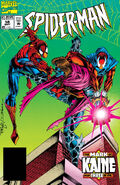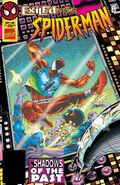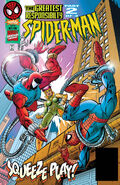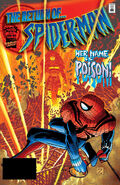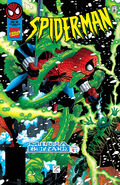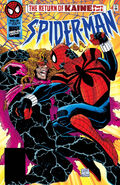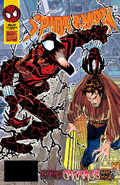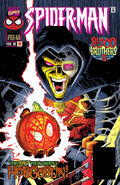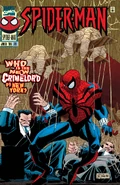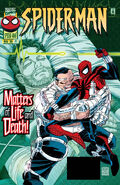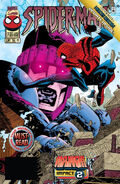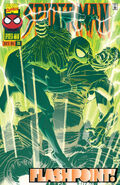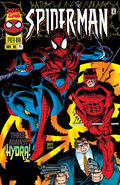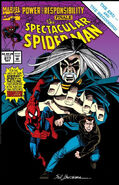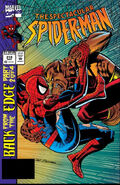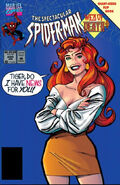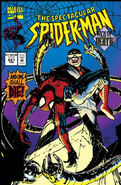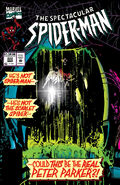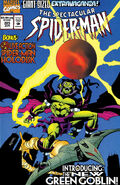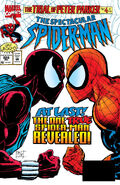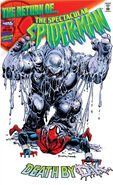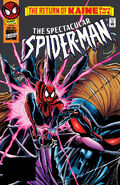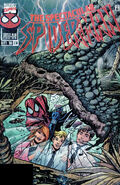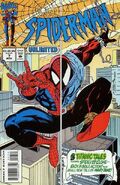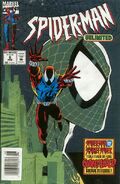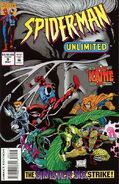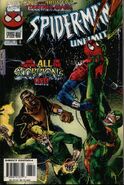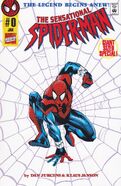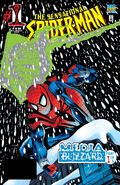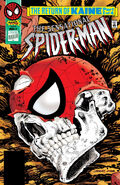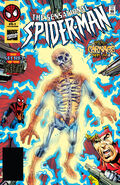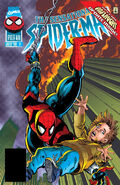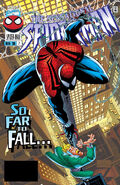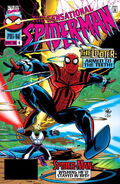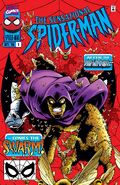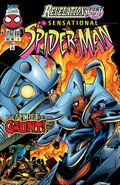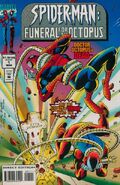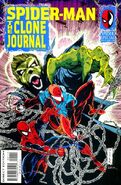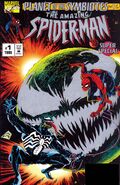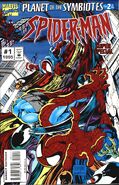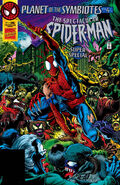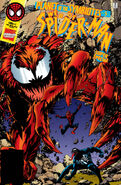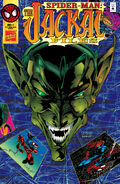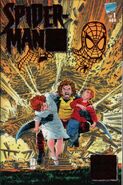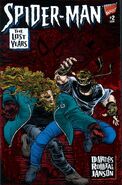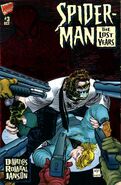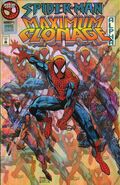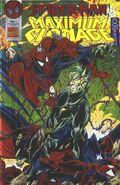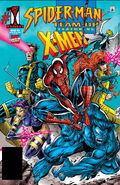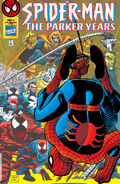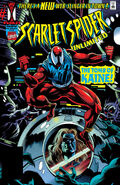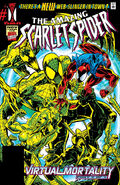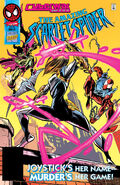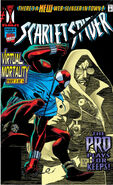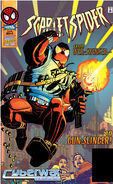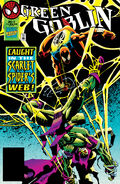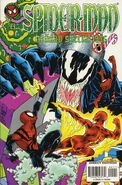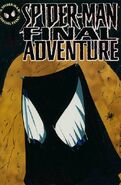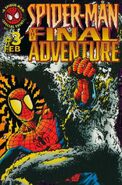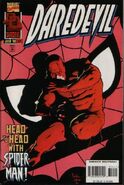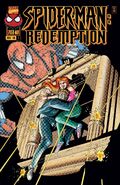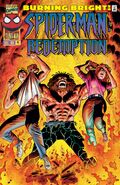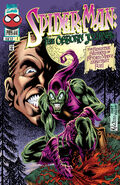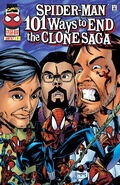Synopsis
A clone of Spider-Man, created years ago and thought dead, reappears. Tests reveal that the clone is the real Spider-Man and Peter Parker is only a clone. Several mysterious figures appear, some clones. But in the end, there is minimal change. The test results were faked, the clone dies, Parker remains Spider-Man.
Yet there is a lot to credit the Saga with. It introduced the major characters Kaine and Phil Urich. It brought back Norman Osborn, the original Green Goblin, and elevated him to the status of Spider-Man's #1 enemy. It also brought back Miles Warren.
It introduced the minor, but noteworthy, villains Lady Octopus, Don Fortunato, his son Jimmy-6, and the Grim Hunter. It brought forth and killed the unborn child of Peter and Mary Jane. And of course, Peter will never forget his "brother", Ben Reilly. So despite some people's claims that the Clone Saga was a waste of two and a half years of Spidey material, it changed the face of Spider-Man's world, and ended up defining Marvel in the 1990's.
History[]
Note: To save space, titles in this article are abbreviated:
- ASM = The Amazing Spider-Man
- TSS = Peter Parker, the Spectacular Spider-Man
- SM = Spider-Man
- SMU = Spider-Man Unlimited
- SSM = The Sensational Spider-Man
- WOS = Web of Spider-Man
Background in the Books[]
In Amazing Spider-Man #121 (June 1973), Gwen Stacy died after the Green Goblin threw her off a bridge. In the next issue, the Green Goblin died when his own glider hit him in the chest. It was a landmark event in comic-book history: not one but two major characters died in very permanent ways.
Then a clone of Gwen Stacy appeared. Spider-Man eventually learned that Professor Miles Warren had created her, along with a clone of Parker himself. Warren (calling himself the Jackal) and the Parker clone died in an explosion (ASM 149 (October 1975)), and Spider-Man dumped his clone's body in a factory smokestack (ASM 151 (December 1975)). The Gwen's clone left town. One sliver of uncertainty remained: the real Parker might have died in the explosion, and the survivor only thought he was the original. Parker realized, however, that the clone could not have his recent memories.
A clone of Warren appeared as the first Carrion but also seemed to die (TSS 31 (June 1979)).
The Gwen Stacy's clone returned years later. The High Evolutionary wanted to duplicate Warren's success at cloning; instead he found, through examining Stacy, that Warren had created a virus that only simulated cloning. "Gwen Stacy" was really a woman named Joyce Delaney, not a clone (TSS Annual 8 (1988)). A second Carrion surfaced, also a victim of the virus (TSS 149 (April 1989)).
Background in the Bullpen[]
The same person, Gerry Conway, wrote all the preceding stories. Reader reaction, although divided at the time, has confirmed the decision to kill Stacy and Osborn as a good one. A mark of the story's impact is that Stacy has never been brought back; the clone was Conway's way of warning later writers to leave her be, and his "cloning virus" retcon should have tied up all the loose ends.
Act 1 in the Books[]
Aunt May had been seriously ill. A mysterious figure came to her bedside, revealed in Spectacular Spider-Man #216 (September 1994) as a twin of Peter Parker named Ben Reilly. Also, Parker (never a picture of mental health) had been edging into schizophrenia, even thinking of his Spider-Man persona as a separate person.
The event began with several crossover stories. In Power and Responsibility (WOS 117, Amazing Spider-Man #394, Spider-Man #51, Spectacular Spider-Man #217 (October 1994)) Parker almost went insane. At the Ravencroft Institute, two mysterious figures, Judas Traveller and Scrier, forced Reilly to fight Parker. Reilly and Parker briefly teamed up against Traveller, but Reilly was caught in an explosion and disappeared.
The The Exile Returns story (WOS 118, Spider-Man #52 (November 1994); Web of Spider-Man #119, Spider-Man #53 (December 1994)) focused on Reilly. He became the Scarlet Spider and defeated Venom, unaware that Parker and Venom had made a non-aggression pact. Venom's own mini-series, Separation Anxiety (December 1994 - March 1995), dealt with him getting his symbiote back.
In the Back from the Edge story (ASM 395, Spectacular Spider-Man #218 (November 1994); Amazing Spider-Man #396, Spectacular Spider-Man #219 (December 1994)) Parker began a painful journey to regain his sanity. He consulted Daredevil, who had his own troubles with his secret identity, and then got poisoned by the Vulture.
SMU 7 (November 1994) served as a brief interlude between the The Exile Returns and Back from the Edge stories.
The Web of Life crossover (WOS 120, Spider-Man #54 (January 1995); Web of Spider-Man #121, Spider-Man #55 (February 1995)) showed Reilly settling into his new/old life, and encountering Betty Brant and J. Jonah Jameson. He met Kaine, another mysterious figure from his past, who then killed the Grim Hunter for some reason.
The Web of Death story (ASM 397, Spectacular Spider-Man #220 (January 1995); Amazing Spider-Man #398, Spectacular Spider-Man #221 (February 1995)) continued Parker's climb back to sanity. Doctor Octopus, his mortal enemy, counteracted the poison for some reason. Kaine then killed Doctor Octopus for some other reason. It was all rather pointless. However, the silver lining arose when Parker's wife, Mary Jane Watson, told him that she was pregnant.
In Spider-Man Unlimited #8 (February 1995), everyone found out that Doctor Octopus had mysteriously been murdered, while the Funeral for an Octopus limited series (March - May 1995) involved his funeral, and both Spider-Man and the Scarlet Spider taking on the Sinister Six, each not knowing that the other was involved.
Smoke and Mirrors brought the two story lines, as well as Parker and Reilly, knowingly back together (WOS 122, Amazing Spider-Man #399, Spider-Man #56 (March 1995)). They battled a new Jackal and a mysterious figure called the Guardian, who both turned out to be clones of Parker. Another Jackal appeared and claimed to be Miles Warren, because the Jackal who died was not the original Warren, but a clone. Not only that, but Parker and Reilly might both be clones. The Jackal escaped in yet another explosion.
The Clone Journal one-shot (March 1995) featured Reilly's reflections, and was basically a recap of everything that had happened so far from his perspective.
In Players and Pawns (TSS 222 (March 1995); WOS 123, Amazing Spider-Man #400 (April 1995)) another Parker's clone (later known as Spidercide) appeared from the rubble of the Jackal's lab. The Jackal attacked Reilly, but was defeated and got sent to the Ravencroft Institute. Aunt May almost recovered, told Parker that she knew he was Spider-Man, and seemingly died. (It was later revealed that this was never Aunt May at all, but a genetically-modified actress) Shortly thereafter, police lieutenant Jacob Raven of Salt Lake City, who had been tracking Reilly, appeared and arrested Parker for the murder of his partner.
Act 1 in the Bullpen[]
In 1994, the staff responsible for the Spider-Man titles began planning for the 400th issue of The Amazing Spider-Man. Management wanted an event to compare with Age of Apocalypse, which had boosted sales of the X-Men titles. Terry Kavanagh proposed bringing back the Spider-Clone from 1975. The idea might have died if J. M. DeMatteis had not championed it. Lacking anything better, the team ran with it.
The event would have three acts: Reilly and Parker learn that they switched lives five years ago, i.e. Parker is the clone; they struggle with the question of who deserves to be Spider-Man; Parker dies nobly, and Reilly takes over as Spider-Man. The fans might not like it at first, but it would shake up the status quo and let the staff reinvent the character of Spider-Man.
Marvel Comics, however, was undergoing a process they called Marvelution. Ronald Perelman had bought Marvel in 1989, when it was making money, and set about maximizing the return on his investment: Marvel comic books became a commodity; prices went up, quality went down. Comic-book fans are better educated, more brand loyal, and more sensitive to quality than the typical consumer. If you buy Spider-Man titles, for instance, you do not switch to Batman if the price is lower. If the quality of those Spider-Man titles drops below a certain (subjectively determined) level of quality, though, you will stop buying them. Perelman and the rest could easily have learned those facts about their new customers, but they either didn't bother or didn't care.
The new management clustered titles under teams of editors. All the Spider-Man books, for instance, fell under the control of Danny Fingeroth, Eric Fein, Mark Powers, and Mark Bernardo. The editor in chief was Tom DeFalco. In this "profit or die" atmosphere, no job was safe, and the marketing department had a veto over creative decisions. Their first directive was to stretch out the event to maximize sales. The clones, like the schedule, began to multiply. The obligatory "shock ending" in ASM 400 became the death of Aunt May, something that nobody wanted and that was later reversed. Once again, though, they lacked anything better.
Act 1 1/2 in the Books[]
The first casualty of the enforced delay was tight plotting. The story Aftershocks (SM 57, Spectacular Spider-Man #223 (April 1995)) explored some more aspects of the new characters and of Reilly's background after he left NYC five years prior.
The next chapter, Mark of Kaine (WOS 124, Amazing Spider-Man #401, Spider-Man #58, Spectacular Spider-Man #224, Spider-Man Unlimited #9 (May 1995)), started to develop Kaine's character, who kidnapped Watson. Traveller helped Parker escape from prison to rescue her. Parker, Reilly, and Spidercide, who believed himself to be the original Parker, battled Kaine. Spidercide turned out to be a shape-changing maniac and apparently died in an explosion. Reilly took Parker's place in prison.
In another loss of cohesion, the next issue did not belong to a crossover but stood alone. It also demonstrated that no part of Conway's stories could escape retconning. In Web of Spider-Man #125 (June 1995) Parker, wearing the Scarlet Spider costume, tracked a clone of Miles Warren and the original Gwen Stacy's clone to a house in New Jersey. They tried to escape, but while crossing that bridge (where Stacy died), their car crashed. A new Green Goblin rescued Gwen, but when she fell off the bridge, Parker rescued her. Warren met the fate of every clone and degenerated. Stacy learned that she was not another woman pretending to be a clone (as the High Evolutionary had claimed) but a clone pretending to be another woman pretending to be a clone; in other words, the retcon was retconned. It later turned out that this new Green Goblin was Phil Urich.
Crossfire (ASM 402, Spider-Man #59 (June 1995)) brought Traveller back into the mix, who fought Parker (still in the Scarlet Spider costume), and was revealed to seemingly have power over space and time.
Another one-issue story (TSS 225 (June 1995)), brought Phil Urich back into the spotlight, who turned out to be a heroic Goblin, showed Parker getting rid of that awful Scarlet Spider costume he had acquired, and revealed that Spidercide survived the previous explosion.
The Trial of Peter Parker (WOS 126, Amazing Spider-Man #403, Spider-Man #60, Spectacular Spider-Man #226 (July 1995)) dropped hints about Reilly's time away from New York. Kaine was revealed as yet another Parker clone and as the real killer of Raven's partner. Seward Trainer, an old friend of Reilly's, tested Parker and Reilly, and announced that Parker was the clone.
Act 1 1/2 in the Bullpen[]
The central revelation of the Clone Saga came out three months behind schedule. Following the marketing department's orders, the staff began to put out limited series and one-shots to boost sales even further, although by design they had nothing significant to do with the story.
Act 2 in the Books[]
Spider-Man: The Jackal Files (August 1995) was a collection of pinups, but it also served as a prologue to Maximum Clonage. Spider-Man: The Lost Years (August-October 1995), a three-part miniseries, began to fill out Reilly's and Kaine's backstories. The readers, of course, would want to know more about the new Spider-Man, even if they didn't know it yet. For instance, he once fell in love with a woman named Elizabeth Tyne.
Maximum Clonage (New Warriors 61, Maximum Clonage Alpha, Web of Spider-Man #127, Amazing Spider-Man #404, Spider-Man #61, Spectacular Spider-Man #227, Maximum Clonage Omega (August 1995)) brought the Jackal back to center stage. With an aerosol bomb, he hoped to mutate all of humanity into an ideal form. Parker and Reilly stopped his plan, and Warren fell to his death trying to save the Gwen's clone. During this story, hundreds of Spider-Clones chased Reilly through the city and then degenerated. Spidercide finally died, and Kaine apparently did so as well, without revealing why he had kidnapped Mary Jane earlier. It was to protect her from someone... someone she loved...
The Exiled story (WOS 128, Amazing Spider-Man #405, Spider-Man #62, Spider-Man Unlimited #10 (September 1995)) appeared to resolve the question of who would be Spider-Man. Reilly tried to leave town again, but after defeating the Vulture, decided to stay. Meanwhile, Peter started to have bizarre dreams about killing Mary Jane.
Time Bomb (TSS 228 (September 1995); Web of Spider-Man #129 (October 1995)) was a postscript to Maximum Clonage. Before he died, the Jackal activated a command he had implanted in the clone's mind: to kill the one he loved most. Parker tried to kill Watson, so he was definitely the clone. Unless the Jackal had just implanted that command in him when he had kidnapped him at some earlier point.. but nah, Parker clearly was the clone.
In The Greatest Responsibility (ASM 406, Spider-Man #63, Spectacular Spider-Man #229 (October 1995)), Parker realized that his responsibility to his unborn child outweighed his responsibility to use his powers. He left the job of Spider-Man to Reilly. Meanwhile, Carolyn Trainer, the daughter of Seward Trainer, was introduced as a female Doctor Octopus.
A one-shot, Spider-Man: The Parker Years (November 1995), flashed back to the highlights (and lowlights) of Parker's career, before he left.
Act 2 in the Bullpen[]
The title Maximum Clonage obviously came from Maximum Carnage, an earlier Spider-saga. The Alpha and Omega one-shots were supposed to remind readers of the recent Age of Apocalypse epic. No one had any better ideas. This six-part event within an event was supposed to wrap up the Clone Saga and replace Parker with Reilly. Instead, it graphically illustrated what happens when you take a marketing maxim, "If some is good, more is better," to its logical conclusion. However, the story did reach the planned end of the second act: Reilly would take over as Spider-Man.
During this time, DeMatteis became frustrated with the delays and quit, to be replaced by Tom DeFalco. Kavanagh left because of creative differences with Fein and was replaced by Todd DeZago. Remember that Kavanagh and DeMatteis were responsible for the Clone Saga in the first place. Fingeroth also left.
Act 3 (Fake) in the Books[]
Scarlet Spider Unlimited 1 (November 1995) attempted to explain away some of the inconsistencies that had crept into the saga. Reilly, taken to Mount Wundagore, learned that the High Evolutionary had lied to Parker and Delaney (in TSS annual 8) because he was jealous of Warren's success. Warren's clones were real (already shown in WOS 125), meaning that the "cloning virus" was fake.
In the chapter Virtual Mortality (Web of Scarlet Spider 1, Amazing Scarlet Spider #1, Scarlet Spider #1, Spectacular Scarlet Spider #1 (November 1995)) Reilly started to settle into his new life.
Cyberwar (Web of Scarlet Spider 2, Amazing Scarlet Spider #2, Scarlet Spider #2, Spectacular Scarlet Spider #2 (December 1995) continued with Reilly, who then adopted a new Spider-Man costume.
The Cyberwar story was briefly interrupted by Green Goblin #3 (December 1995), where the Scarlet Spider and the all-new Green Goblin were introduced to the super-powered competition known as the Great Game.
A new title, The Sensational Spider-Man, replaced the least popular spider-book, Web of Spider-Man. The next few issues (SSM 0, Amazing Spider-Man #407, Spider-Man #64, Spectacular Spider-Man #230, Spider-Man Unlimited #11 (January 1996)) showed Reilly convincing people that despite the costume and attitude change, he was the genuine Spidey, which was actually a lie.
Meanwhile, in a four-part miniseries, Spider-Man: The Final Adventure (December 1995 - March 1996), Peter and Mary Jane moved to Portland. In a final irony, the corporation that was responsible for giving Parker his powers took them away. Everything was ready for Reilly to take Parker's place permanently. The Clone Saga was over.
Act 3 (Fake) in the Bullpen[]
During the Age of Apocalypse event, all the X-Men books had changed their titles for four months. The marketing department wanted all the Spider-Man books changed to Scarlet Spider for four months. In a rare compromise, they settled for two months.
As originally plotted, The Final Adventure was supposed to culminate in the birth of Parker and Watson's child. After the usual delays and wrangling, the ending changed.
DeFalco was fired as editor in chief but stayed on as writer on ASM.
Act 2 Do-Over in the Books[]
Media Blizzard (SSM 1, Amazing Spider-Man #408, Spider-Man #65 (February 1996)) continued to establish Reilly as the new Spider-Man. He took on Mysterio, who had incorporated new technology into his powers of illusion, and beat him.
Although centered on Kaine, who was still alive, The Return of Kaine (TSS 231 (February 1996); Sensational Spider-Man #2, Amazing Spider-Man #409, Spider-Man #66 (March 1996)) introduced another Spider-Clone. This one was a skeleton found in the smokestack where Parker dumped Reilly's "body," way back in ASM 151.
TSS 232 (March 1996) brought Peter and Mary Jane back from Portland after they had heard about the skeleton.
Web of Carnage (SSM 3, Amazing Spider-Man #410, Spider-Man #67, Spectacular Spider-Man #233 (April 1996)) shoehorned a popular foe into the Clone Saga.
Act 2 Do-Over in the Bullpen[]
No better example shows the chaos going on in the Bullpen than the skeleton. Someone had the idea, so it went into the pot. Nobody had any idea where it had come from or what it meant, but someday it might contribute to the final result. No one had the time or imagination to work it into the story in a plausible way, so it became one of many loose ends.
Finally and fatefully, Budiansky made a decision, possibly the only one that readers would accept: Peter Parker would remain Spider-Man. More than a year of preparation and hard work instantly became invalid. Not only did the staff still have to find a way to end the Clone Saga, they would have to undermine, even contradict, much of the groundwork they had already laid for it.
Act 2 1/2 in the Books[]
Blood Brothers (SSM 4, Amazing Spider-Man #411, Spider-Man #68, Spectacular Spider-Man #234 (May 1996); (SSM 5, Amazing Spider-Man #412 (June 1996)) promised some answers. Yet another mysterious figure, Gaunt, appeared, who had a connection to Trainer. Jason Macendale, the current Hobgoblin, also showed up, with his own connection to one more (and the last) mysterious figure.
SM 69 (June 1996) served as an aftermath to Blood Brothers, where Reilly was cleared for burning down his current place of employment, the Daily Grind; Gaunt severed ties with the Hobgoblin, who was taken down by Reilly and finally arrested for murdering Need Leeds years earlier, among other crimes; and Parker was injured.
SMU 12 (May 1996), which chronologically took place after Blood Brothers and its aftermath, got rid of the skeleton that had hastily been thrown into the Saga. It was not mentioned again until the Saga had ended.
TSS 235 (June 1996) revealed that Peter's injuries were still acting up, which was a sign for concern. Meanwhile, in Sensational Spider-Man #6 (July 1996), the Daily Grind was rebuilt, and Reilly's relationships with his co-workers were too. In addition, his current girlfriend Jessica, the daughter of the Burglar that had shot Uncle Ben, and who had learned that he was Spider-Man, forgave him for being involved with her dad's death, after watching him perform selfless acts as Spider-Man. However, she chose to leave his life.
ASM 413 (July 1996) involved Reilly fighting Mysterio again, and Peter once again having an incident, this time resolving to tell Mary Jane his concerns. But first, Reilly teamed up with Daredevil in Daredevil #354 (July 1996).
Another limited series, Spider-Man: Redemption (4 issues, September-December 1996), a sequel to Lost Years, but which chronologically took place at that moment in time, resolved the story of Reilly and Kaine. Elizabeth Tyne found Reilly again, but surrendered herself for murdering her evil father years ago. Kaine surrendered as well and was not heard from again for the rest of the Saga. This noble action ironically may have been what ultimately spared him, since by the end of it all, every other clone of Spider-Man would have been dead.
At the end of Spider-Man #70 (July 1996), Peter's injuries took a toll for the worse, and he fell into a brief coma. He was rushed to the hospital in Spectacular Spider-Man #236 (July 1996), and Mary Jane tried to call Reilly, who was busy fighting bad guys.
Act 2 1/2 in the Bullpen[]
The staff still faced a huge problem: how to finish off the Clone Saga in a plausible way. Months went by, hundreds of memos traded hands, but Budiansky couldn't make a decision. He was sure about one thing: the mastermind could never be Norman Osborn. That would create more problems than it solved, leave the fans feeling cheated, and undo a classic story. Jurgens quit, frustrated by the delays, by differences with Budiansky, and by his sense that he wasn't working with the "real" Spider-Man. The other writers felt almost as frustrated. Without knowing where Spider-Man would be in a year, or even being sure who would be Spider-Man, it was nearly impossible to start new projects.
Then another reorganization took place. Bob Harras, who had been head editor of the X-Men group, became editor in chief. To keep the Clone Saga from interfering with Onslaught, an event taking place in the X-Men group at that time, he decreed a six-month delay for the Clone Saga. Budiansky and Fein got fired. Ralph Macchio became editor of the Spider-Man group.
Act 2 3/4 in the Books[]
In the August titles (SSM 7, Amazing Spider-Man #414, Spider-Man #71, Spectacular Spider-Man #237) Parker appeared to sicken and die, but he revived with his spider-powers, albeit spotty at first.
September brought a crossover with the Onslaught event (ASM 415, Spider-Man #72). The rest of the six-month delay simply marked time through September (SSM 8, Spectacular Spider-Man #238), October (SSM 9, Amazing Spider-Man #416, Spider-Man #73, Spectacular Spider-Man #239), and November (SSM 10, Amazing Spider-Man #417, Spider-Man #74). The only concession to the Clone Saga was to reveal Traveler as a mutant illusionist and Scrier as a cult instead of one person.
Act 2 3/4 in the Bullpen[]
Whatever skills Harras had as an editor or manager, he knew little about writing comic books. He issued decrees concerning the Spider-Man books, decrees that contradicted continuity, the advice of the staff, logic, and common sense. First, he decreed that the mastermind would be Norman Osborn.
Act 3 in the Books[]
At long last, Revelations (TSS 240 (November 1996); Sensational Spider-Man #11, Amazing Spider-Man #418, Spider-Man #75 (new title) (December 1996)) brought the Clone Saga to an end. Watson went into premature labor after getting drugged. The child was allegedly stillborn, but Alison Mongrain (who gave her the drug) took the child (or its body) to Europe. The final mysterious figure was unmasked as Norman Osborn, the original Green Goblin, long thought dead. In the ensuing battle with Parker and Reilly, the Goblin's jet glider killed Reilly.
Almost as an afterthought, Osborn Journals #1 (February 1997) tried to tie up some loose ends. Additionally, the tongue-in-cheek Spider-Man: 101 Ways to End the Clone Saga #1 (January 1997) mockingly acknowledges the fan and creator exhaustion at the entire affair.
Act 3 in the Bullpen[]
Harras continued to micromanage, going so far as to dictate specific lines of dialog for Revelations. He decreed that Foggy Nelson should appear at the Daily Bugle massacre, even though he had no connection to Spider-Man or to the story. He decreed that Osborn was not responsible for Aunt May's death, even though he later decreed that he was. He decreed that the fate of Watson's child would deliberately be left a mystery, even though that would leave readers feeling cheated. He decreed that Reilly would turn to dust when he died, even though every other clone degenerated into a puddle of goo.
The original plot of Revelations included a journal written by Osborn that would have explained the most embarrassing loose ends of the Clone Saga. This key element got pushed so far into the background that, for certain parts of the saga to make any sense, it became necessary to publish The Osborn Journal separately.
Notes
The Clone Saga in Other Universes[]
- In the MC2 reality, the child of Parker and Watson survived, under the care of Mongrain, and became Spider-Girl (May Parker). A child of Reilly and Elizabeth Tyne merged with Daredevil and a demon and became Darkdevil (Reilly Tyne). Spider-Girl #44 recaps the Clone Saga in a long flashback.
- In Ultimate Spider-Man Norman Osborn is still the Green Goblin, but Miles Warren is his psychiatrist and is dating Aunt May. Gwen Stacy has died, and like before she was cloned but the clone has become Carnage. Curt Connors is still the Lizard, but Ben Reilly is his assistant. The Scorpion and Kaine, among others, are clones of Parker.
The Clone Saga in Other Media[]
- In Spider-Man (1994 animated series), Miles Warren creates clones of Hydro-Man and Watson in "The Return of Hydro-Man" (episodes 59-60), but they degenerate in the end. A more cosmic Clone Saga takes place in "Spider Wars" (episodes 64-65), when Spider-Carnage tries to destroy the Multiverse.
- In Ultimate Spider-Man (animated series), Doctor Octopus created clones of Spider-Man from mixing his DNA with Synthezoids and dubbed them as Spider Slayers. Eventually, Scarlet Spider the perfected clone that would not degenerate, was used as a double agent for Doc Ock to spy on Spider-Man and S.H.I.E.L.D.
See Also
- 3 minor appearance(s) of Clone Saga (Event)
- 10 mention(s) of Clone Saga (Event)
- 181 article(s) related to Clone Saga (Event)
Links and References
- Official Fans of Reilly Thread
- Howard Mackie on the Clone Saga
- Life of Reilly: fairly definitive coverage of the Clone Saga, with commentary by Glenn Greenberg and interviews with Tom de Falco and Mark Bernardo.

